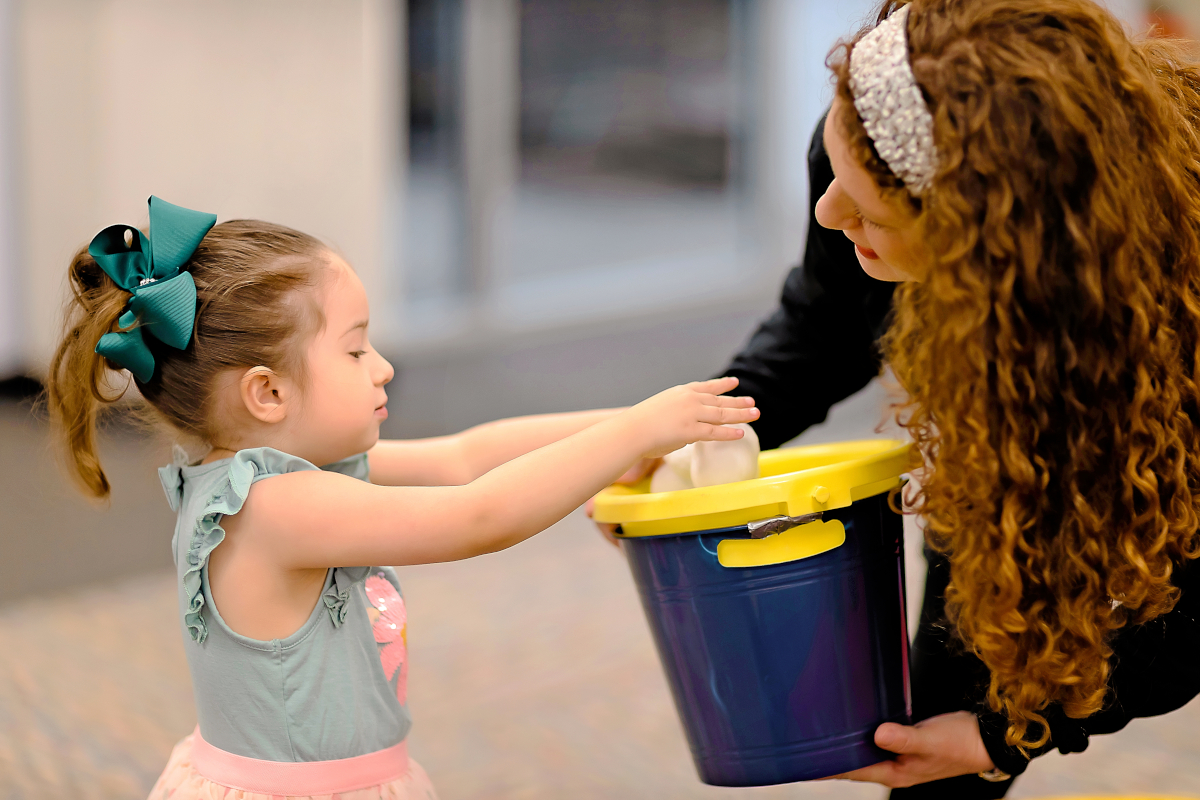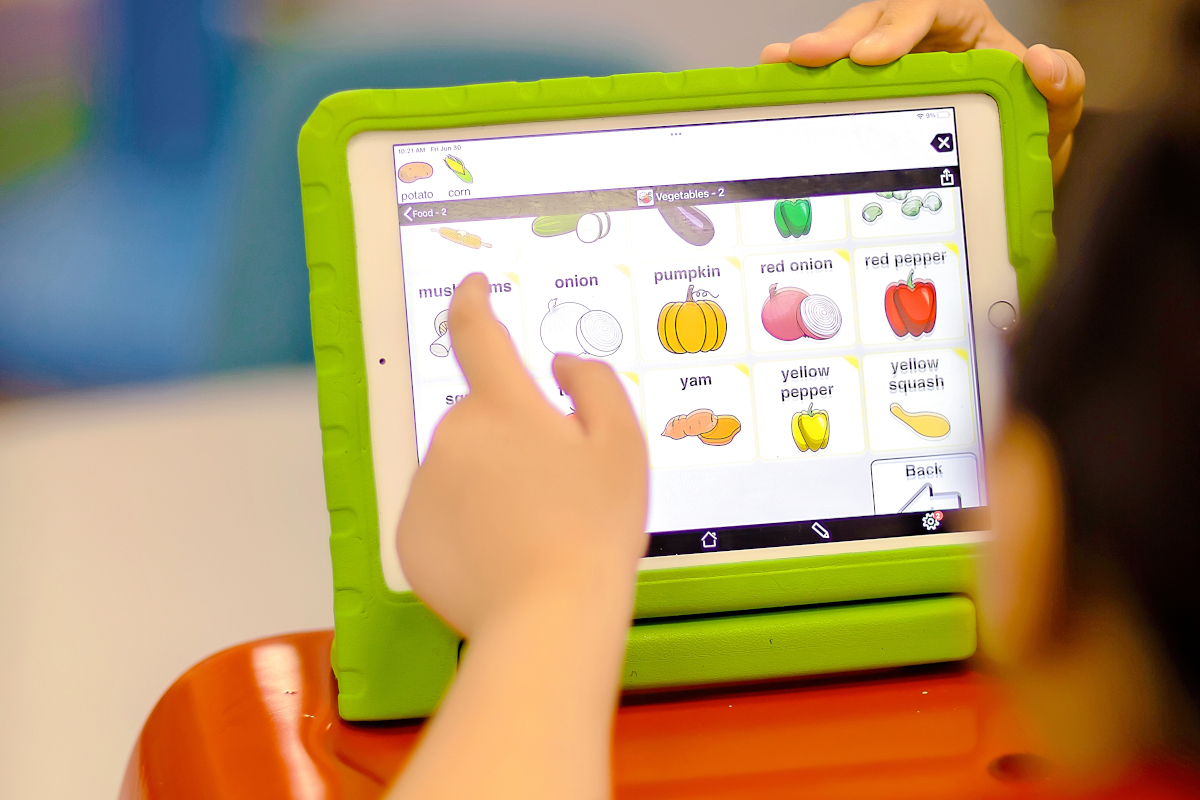At Milestones:
We’ve learned that movement facilitates language, and we take the lesson to heart.

Speech Therapy
Participation in everyday life — making new friends, success at school and work — all can be significantly more difficult when communication or swallowing difficulties exist. Our Speech Therapy (ST) team offers diverse treatments for those who have language, communication, articulation, sequencing, feeding, swallowing or socialization issues. The Milestones ST team will develop a custom intervention program to facilitate your child’s communication and/or feeding needs in collaboration with their therapy team.
Patients referred to Milestones often have significant feeding or swallowing issues that impact their ability to take in adequate nutrition to fuel brain and body development. As part of our comprehensive team approach, we partner with Professional Imaging to provide on-site mobile swallow studies.
Several of the techniques our Speech Therapy Team may use include:
Several of the techniques our Speech Therapy Team may use include:
Case Studies
-
18 - Y E A R - O L D B O Y
Cerebral Palsy
Jacob’s primary speech therapist quickly identified eye gaze as a strength. After successful funding of a Tobii Dynavox with eye gaze technology, the patient was taught how to utilize his device to communicate. One of the first phrases he communicated was, "I love you," to his mother, causing the room to fill with tears.
-
7 - Y E A R - O L D B O Y
Delayed Language Abilities
David presents with delayed language abilities and receives multidisciplinary treatment. David initially demonstrated oral musculature deficits, while solely consuming puree consistencies as he had difficulty with chewing, drinking, and swallowing. During his twice-weekly speech therapy sessions, we provided language/feeding treatment while implementing evidence-based practices: total communication approach, postural/positioning techniques, diet modifications, responsive feeding, and sensory stimulation techniques. He now communicates via sign language, open vocalizations, and an augmented or alternative communication device (AAC). David has made the safe transition to soft, bite-sized foods, drinking with a straw, and is currently working on easy-to-chew regular consistency foods.
-
8 - Y E A R - O L D B O Y
Phelan McDermid Syndrome, Autism
Initially, Jayden was unable to communicate his emotions, thoughts and wants. He has learned to communicate utilizing his Dynavox, a speech generating device. Jayden is now able to navigate through Dynavox folders, understands basic concepts, pronouns, prepositions and is able to make 2-3 utterances. Recently, he is verbalizing and counting. Through the use of Bjorem pictorials he is now able to express vowels and a variety of consonants upon imitation. He is able to say the following new words: eat, tea, and, this, one.
-
6 - Y E A R - O L D G I R L
Autism Spectrum Disorder
Emma has global language delays severely affecting her social behavior and ability to express her wants and needs. During her twice weekly speech therapy appointments, we targeted functional scripts using an augmented or alternative communication device (AAC). Emma is now able to make requests, decline undesired activities, and answer simple questions across multiple settings including therapy, home, and at school!
-
7 - Y E A R - O L D B O Y
Nonverbal
Daniel’s smile lights up the room. He is nonverbal and does not have use of his hands to use sign language or direct touch on an augmentative communication device. When Daniel first began therapy, he would use eye gaze and facial expression to communicate, but he had so much more to say. When he was 3 years old, he was introduced to speech-generating devices with eye gaze interaction. At first Daniel would shut down in frustration. Eye control was going to be the only communication method for him so we had to make it work. Within a year of obtaining his dedicated device, Daniel was using eye control to greet, request, ask, answer, comment, and tell jokes. With the help of skilled speech therapy and a dedicated and supportive family, Daniel is now using his device to participate in a regular education class with his peers. He takes tests, makes friends, and communicates his wants and needs using his device.
Case Studies
-
18 - Y E A R - O L D B O Y
Cerebral Palsy
Jacob’s primary speech therapist quickly identified eye gaze as a strength. After successful funding of a Tobii Dynavox with eye gaze technology, the patient was taught how to utilize his device to communicate. One of the first phrases he communicated was, "I love you," to his mother, causing the room to fill with tears.
-
7 - Y E A R - O L D B O Y
Delayed Language Abilities
David presents with delayed language abilities and receives multidisciplinary treatment. David initially demonstrated oral musculature deficits, while solely consuming puree consistencies as he had difficulty with chewing, drinking, and swallowing. During his twice-weekly speech therapy sessions, we provided language/feeding treatment while implementing evidence-based practices: total communication approach, postural/positioning techniques, diet modifications, responsive feeding, and sensory stimulation techniques. He now communicates via sign language, open vocalizations, and an augmented or alternative communication device (AAC). David has made the safe transition to soft, bite-sized foods, drinking with a straw, and is currently working on easy-to-chew regular consistency foods.
-
8 - Y E A R - O L D B O Y
Phelan McDermid Syndrome, Autism
Initially, Jayden was unable to communicate his emotions, thoughts and wants. He has learned to communicate utilizing his Dynavox, a speech generating device. Jayden is now able to navigate through Dynavox folders, understands basic concepts, pronouns, prepositions and is able to make 2-3 utterances. Recently, he is verbalizing and counting. Through the use of Bjorem pictorials he is now able to express vowels and a variety of consonants upon imitation. He is able to say the following new words: eat, tea, and, this, one.
-
6 - Y E A R - O L D G I R L
Autism Spectrum Disorder
Emma has global language delays severely affecting her social behavior and ability to express her wants and needs. During her twice weekly speech therapy appointments, we targeted functional scripts using an augmented or alternative communication device (AAC). Emma is now able to make requests, decline undesired activities, and answer simple questions across multiple settings including therapy, home, and at school!
-
7 - Y E A R - O L D B O Y
Nonverbal
Daniel’s smile lights up the room. He is nonverbal and does not have use of his hands to use sign language or direct touch on an augmentative communication device. When Daniel first began therapy, he would use eye gaze and facial expression to communicate, but he had so much more to say. When he was 3 years old, he was introduced to speech-generating devices with eye gaze interaction. At first Daniel would shut down in frustration. Eye control was going to be the only communication method for him so we had to make it work. Within a year of obtaining his dedicated device, Daniel was using eye control to greet, request, ask, answer, comment, and tell jokes. With the help of skilled speech therapy and a dedicated and supportive family, Daniel is now using his device to participate in a regular education class with his peers. He takes tests, makes friends, and communicates his wants and needs using his device.
Questions?
For more information about our ST team or to make an appointment, please contact Denise Alanis, Clinical Excellence Leader for Speech-language Pathology Services:
